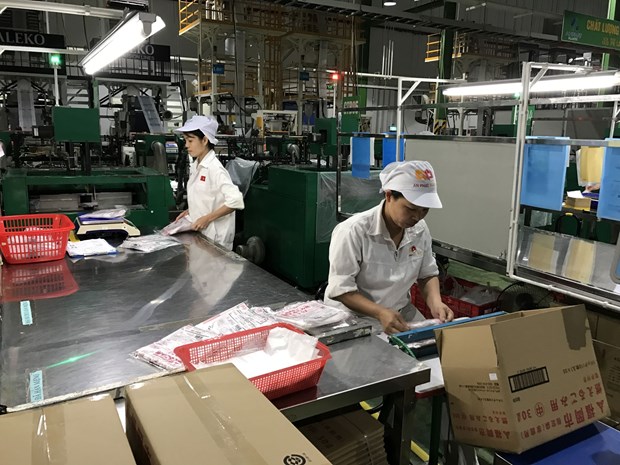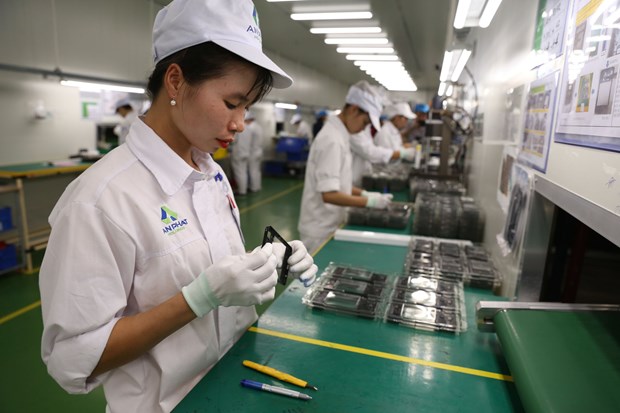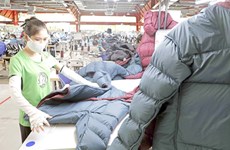RCEP: local enterprises stepping firmly forward
 The company has invested in new technologies to raise its competitiveness. (Photo: VNA)
The company has invested in new technologies to raise its competitiveness. (Photo: VNA)
Hanoi (VNA) - The commitment to market opening and tax incentives in the Regional Comprehensive Economic Partnership (RCEP) agreement will generate huge opportunities for Vietnam to increase its share in the 26 trillion USD market.
However, to fully realise the deal, each business must better its competitiveness and adaptability given the strict market requirements, experts have suggested.
Anticipating “waves”
On November 15, four months after the EU-Vietnam Free Trade Agreement (EVFTA) took effect, Vietnam and other ASEAN member countries officially signed the RCEP agreement with five big partners – Australia, China, Japan, the Republic of Korea (RoK) and New Zealand.
ASEAN groups 10 member nations - Brunei, Cambodia, Indonesia, Laos, Malaysia, Myanmar, the Philippines, Singapore, Thailand, and Vietnam.
The signing of the deal whose negotiations lasted for up to eight years has given a new boost to regional trade, especially the signatories, said Deputy Minister of Foreign Affairs Nguyen Quoc Dung.
This is significant to Vietnam in its capacity as ASEAN Chair 2020 that has worked hard to push ahead with the process.
Under the agreement, Vietnam and its partners will remove tariffs on at least 64 percent of tariff lines.
After 15 to 20 years, Vietnam will remove 89.6 percent of tariff lines for partner countries which, in return, will eliminate up to 92 percent of tariff lines for Vietnam. Other ASEAN members will cut 85.9 percent of all tariffs for Vietnam.
Telecommunications, information technology, machinery, spare parts, chemicals, and agricultural products will immediately benefit from the deal.
With products whose quality and prices satisfy local consumers, Santa Food JSC has gained a firm foothold in such markets as China and Malaysia.
Once RCEP is effective, the company would step up its export and integrate more intensively in the global supply chain.
According to Cao Minh Sang, Director of Santa Food JSC, who is anticipating the trade deal, his company has made preparations regarding market regulations and goods standards.
“We hope that RCEP coming into force will make it easier for market access, thus helping our company increase export value from 15-20 percent,” Sang said.
Statistics by the Ministry of Industry and Trade (MoIT) showed that Vietnam’s export to certain markets has remained rosy in the face of the COVID-19 pandemic.
Between January and November, the country’s export revenue to Australia and China – two of the 15 RCEP signatories - expanded by 1.5 percent and 16 percent, respectively, the ministry said, adding that that the trade pact is predicted to make marked changes.
Pham Thiet Hoa, General Director of Saigon Agriculture Incorporation Company, said with 15 signatories that make up 30 percent of the global GDP, RCEP would offer huge opportunities for exporters.
Moreover, the favourable geographical location of the RCEP member countries has also facilitated the circulation of their goods.
Vietnamese firms should stay vigilant as businesses in the grouping would also utilise advantages from the deal to “attack” the domestic market, Hoa said, suggesting the local enterprises consolidate their foothold right in the home market and improve their competitiveness in pricing and quality.
General Secretary of the Vietnam Association of Seafood Exporters and Processors (VASEP) Truong Dinh Hoe said RCEP integrates certain FTAs ASEAN had signed. Therefore, once put into place, the trade deal will allow businesses to use a common certificate of origin (CO) instead of the current single certificate for each market.
Ready to create a new game
It can be said that Vietnamese enterprises have never engaged in a bigger playground. However, to materialise opportunities generated by the agreement, To Hoai Nam, General Secretary of the Vietnam Association of Small-and Medium-sized Enterprises (VINASME) suggested businesses study the current regional and global supply chains to evaluate the impact of the pact on future business models.
This is crucial not only for businesses that are based in the member markets but also for those that operate in the region.
 RCEP will open up many market opportunities. (Photo: VNA)
RCEP will open up many market opportunities. (Photo: VNA)To avoid “market shocks,” experts said enterprises should look into tax impact on groups of goods and services so as to put forth suitable business strategies, and optimise competitiveness advantages.
Specifically, they need to pour more investments in personnel, machinery and technology, towards development research, product design, improving productivity and cost reduction at the maximum level.
Frederick R.Burke, Director of Baker&Mckenzine Vietnam, said the mammoth trade deal covers the majority of production chains of many products that are Vietnam’s strength like garments-textiles, farm produce, equipment and electronics.
He proposed the Vietnamese State provide specific guidance on tax reduction roadmap for businesses in order to make the best use of the pact./.












